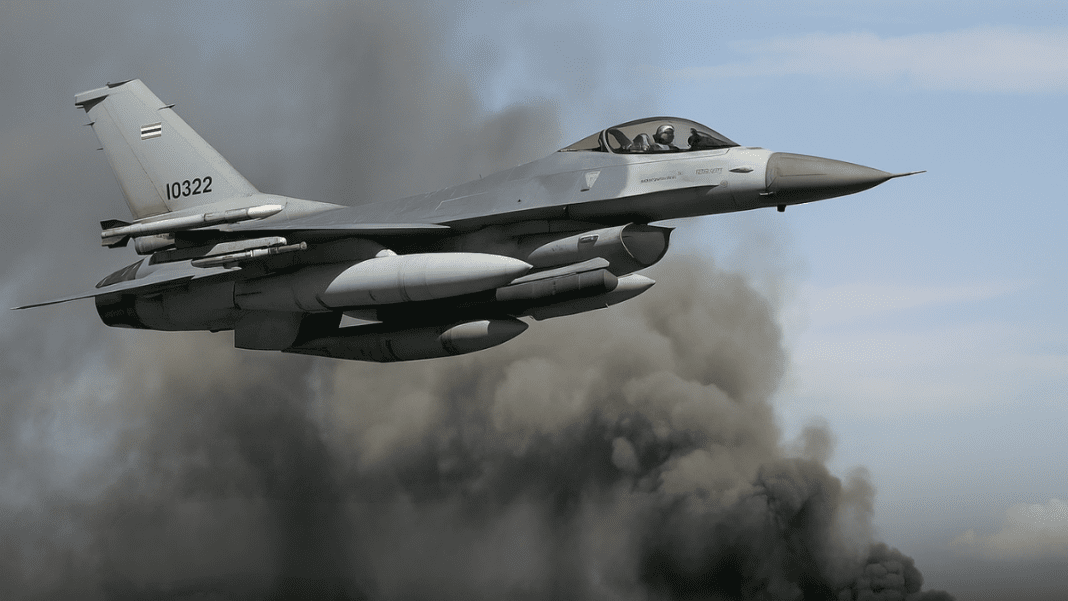F-16 fighter planes carried out airstrikes on two military targets in Cambodia. It said that six fighter planes hit two “Cambodian military targets on the ground”.
Rising Tensions at the Thailand-Cambodia Border
The long-standing Thailand-Cambodia border dispute has taken a dangerous turn. On Thursday, the Thai military confirmed that it had deployed one of its F-16 fighter jets to strike a Cambodian military target. This dramatic move comes after weeks of growing tension between the two Southeast Asian neighbors. The Thai army said the decision was part of a planned operation targeting military installations in the disputed border zone.
Thailand had stationed six F-16 fighter jets near the Thailand-Cambodia border in preparation for any escalation. According to the Thai military, one jet was used in an airstrike that successfully destroyed a target inside Cambodian territory. Both countries are accusing each other of starting the clash, which turned violent early Thursday morning.
The area of conflict lies near the Ta Moan Thom temple, a site that has long been a source of friction in the Thailand-Cambodia conflict. This temple is located along their shared 817-kilometer (508-mile) border, much of which remains poorly marked. Over the years, both nations have laid claim to different parts of the land, resulting in recurring skirmishes and military standoffs.
📍Missiles over Bangkok? Hun Sen claims Cambodia can strike Thai capital with China-made arms
Thailand-Cambodia Conflict Causes Civilian Casualties and Evacuations
The violence has already taken a toll on civilians. Thai officials confirmed that two people lost their lives after artillery shells landed in residential areas. The shells were reportedly fired from the Cambodian side of the border, damaging homes and forcing thousands to flee. Around 40,000 residents from 86 villages in Thailand’s Surin province were evacuated to safer locations. Local authorities acted quickly to move people away from the conflict zone and set up temporary shelters.
Cambodian officials have also claimed that two of their provinces were hit by shelling from the Thai military. However, they have not yet officially confirmed the airstrike involving the F-16 fighter jet. Tensions have been high for weeks, but the use of air power marks a significant escalation in the Thailand-Cambodia conflict.
Thailand Tries to Calm U.S. Tariff Fury with Open Market & $6B Safety Net
What started as isolated gunfire has now evolved into a wider armed confrontation. Artillery, landmines, and airstrikes have turned the disputed area into a zone of danger for both military personnel and civilians. The violence follows several recent incidents that have added fuel to the fire, including the deaths and injuries of soldiers from both sides in the ongoing Thailand-Cambodia standoff.
Landmines and Accusations Intensify the Conflict
Landmines have become a major point of contention in this recent flare-up. Thailand has accused Cambodia of planting new landmines in the disputed area. These mines reportedly caused injuries to at least three Thai soldiers, including one who lost a limb. In response, Thailand recalled its ambassador from Cambodia and also announced plans to expel Cambodia’s ambassador from Bangkok.
Cambodia, however, has strongly denied laying any new mines. Authorities in Phnom Penh argue that the injured soldiers might have stepped on old landmines left over from Cambodia’s long civil war. De-mining organizations estimate that millions of such explosives still remain scattered across the country.
Despite Cambodia’s denial, Thai officials remain firm in their position. They insist that the mines were recently placed and are not remnants from past conflicts. These differing accounts have added more strain to the already fragile Thailand-Cambodia relationship.
Uyghur Refugees Betrayed: US Representative Slams Thailand’s Deportation Move
The Thailand-Cambodia border dispute has lasted for over a century, with both countries occasionally engaging in brief but deadly clashes. One of the most serious incidents occurred in 2011, when a weeklong exchange of artillery fire left at least a dozen people dead. The current situation appears to be one of the most intense escalations since then.
The conflict has not only endangered soldiers but also placed thousands of innocent civilians at risk. With landmines, artillery fire, and now airstrikes involved, the Thailand-Cambodia border remains highly dangerous.
The airstrikes came after Thai officials said earlier in the day that two Thai civilians were killed and two others were injured in Cambodian artillery shelling.

